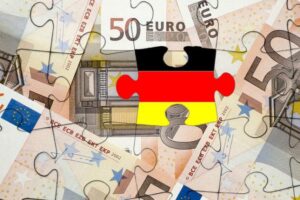
The visualization of the dynamics of the top 20 countries by GDP at purchasing power parity (PPP) for 1991-2024 from the Experts Club analytical center, which went viral on social media, is generally confirmed by international statistics: in 2024, the world’s largest economies in terms of GDP (PPP) China, the US, and India.
According to World Bank data on GDP, PPP (current international $), in 2024, China’s GDP in PPP was estimated at $38.19 trillion, the US at $29.18 trillion, and India at $16.19 trillion. The top ten economies by this indicator also included Russia (4th place), Japan (5th place), followed by Germany, Indonesia, Brazil, France, and the United Kingdom.
The Experts Club notes that the “race” from 1991 to 2024 reflects a long-term shift in the weight of the global economy towards Asia. At the start of the period, developed economies were the leaders, but then markets with large populations and domestic demand grew rapidly, and China and India gradually established themselves among the leaders.
“GDP at PPP does not show ‘wealth in currency’, but rather the scale of the economy, taking into account how many goods and services can actually be purchased within the country. Therefore, PPP better describes the domestic market and consumption potential, while for foreign trade, debt, and capital inflows, it is important to look at nominal indicators in parallel,” commented Maxim Urakin, founder of the Experts Club analytical center and candidate of economic sciences.
The GDP indicator in PPP terms converts the size of the economy into “international dollars,” taking into account differences in price levels between countries, so that the comparison is more accurate than when converted at market rates.
The video analysis by the Experts Club analytical center is available at the link:

Construction, with a rate of 31.5%, made the largest contribution to Ukraine’s GDP growth in the third quarter of 2025, which, according to preliminary data, amounted to 2.1%, the State Statistics Service reported on Thursday.
According to its estimates of GDP using the production method, growth in public administration was 15.1%, in the supply of electricity, gas, steam, and air conditioning – 6.7%, in wholesale and retail trade and repair of motor vehicles – 2.6%, and in education – 2.2%.
In calculating GDP using the final use (or expenditure) method, which shows where resources in the economy were directed—to consumption, investment, or public services, the main growth in GDP in the third quarter of 2025 was driven by general government expenditure (12.2%) and gross fixed capital formation (or, more simply, investment) (11.5%).
In addition, final household consumption expenditure grew by 6.7%, according to the State Statistics Service.
“In the third quarter, there were significant shifts in the structure: public finances, investment in fixed capital, and household consumption expenditure strengthened noticeably. In terms of production, the main drivers were construction, the public administration sector, energy, trade, and education. It was these sectors that shaped the positive dynamics of the quarter,” said Igor Gonchar, deputy chairman of the State Statistics Service.
The day before, the State Statistics Service reported that Ukraine’s real GDP in the third quarter of 2025 grew by 2.1% compared to the third quarter of 2024, while in the second quarter of this year the same indicator was 0.8%, and in the first quarter – 0.9%.
As reported, at the end of October, the National Bank also estimated Ukraine’s real GDP growth in the third quarter of 2025 at 2.1% compared to the same period last year, while earlier it had forecast it at 2.4%.
According to the updated forecast, the estimate of real GDP growth in the fourth quarter of this year has been revised down to 3.4% from 3.5% in July.
Overall, the National Bank has lowered its GDP growth forecast for 2025 to 1.9% from 2.1% due to energy shortages, the destruction of gas production facilities, and labor shortages, and for 2026 from 2.3% to 2%. The inflation forecast for this year has been improved from 9.7% to 9.2%, while the forecast for next year has been kept at 6.6%.

Serbia’s real GDP in the third quarter of 2025 increased by 2% in annualized terms, the Statistical Office of the Republic of Serbia ( SERS) reported. According to seasonally cleansed data, GDP grew by 0.6% compared to the second quarter of this year.
The biggest increase in value added was recorded in industry and water supply sector – 2.9%, as well as in information and communication – 6%.
Decrease was noted in construction, where the output decreased by 11.7 %, and in agriculture, forestry and fishing – by 0.2 %.
https://t.me/relocationrs/1870

The Swiss economy contracted by 0.5% in the third quarter of 2025 compared to the previous quarter due to a decline in exports amid the trade conflict with the United States.
Official data confirmed the preliminary estimate announced at the beginning of last week.
This is the first decline in the Swiss economy since the second quarter of 2023.
In August, the US imposed a 39% tariff on imports from Switzerland, the highest rate among all developed economies. The countries later concluded a trade agreement, and the tariff was reduced to 15%.
‘The data should be viewed in the context of recent volatility in foreign trade,’ the press release said. ‘Strong exports of chemical and pharmaceutical products in anticipation of changes in US foreign trade policy triggered a compensatory decline in the following months.’
According to revised data, Swiss GDP grew by 0.2% in April-June (previously estimated at 0.1%).
Earlier, the Experts Club information and analytical centre made a video analysis of the prospects for the Ukrainian and global economies. For more details, see the video — https://youtu.be/kQsH3lUvMKo?si=F4IOLdLuVbYmEh5P

Germany’s GDP remained unchanged in the third quarter of 2025 compared to the previous three months, according to final data from the Federal Statistical Office.
This coincided with both the previously announced data and the consensus forecast of analysts surveyed by Trading Economics.
Germany’s economy grew by 0.3% year-on-year in the third quarter. This figure was also unchanged and in line with experts’ expectations.
“Weak exports had a dampening effect on economic activity in the third quarter, while capital expenditure increased slightly,” said Destatis President Ruth Brand.
Government spending in July-September remained unchanged from the previous three months, while capital expenditure rose by 0.3%. At the same time, consumer spending fell by 0.3%, the first decline in seven quarters.
Exports of goods and services fell by 0.7%, while imports remained unchanged.
In the second quarter, Germany’s GDP fell by 0.2% q/q and rose by 0.3% y/y.
Earlier, the Experts Club information and analytical center released a video analysis of global economic trends and the outlook for the world’s major economies until the end of 2025 – https://youtu.be/kQsH3lUvMKo?si=LnQWU3r2Kd5HesPh
Source: http://relocation.com.ua/germanys-gdp-remained-unchanged-in-the-third-quarter/

Spain’s GDP grew by 0.6% in the third quarter of 2025 compared to the previous three months, according to preliminary data from the national statistics agency INE. Economic growth compared to the same period last year was 2.8%.
Analysts had forecast an average increase of 0.6% for the first indicator and 3% for the second.
The pace of growth slowed: in the second quarter, GDP rose by 0.8% quarter-on-quarter and 3.1% year-on-year.
Consumer spending in Spain rose by 1.2% in July-September compared to the previous quarter, business investment by 1.7%, and government spending by 1.1%.
Exports of goods and services fell by 0.6%, while imports rose by 1.1%.
Industrial production rose by 0.5%. The services sector showed an increase of 0.8%, and the construction industry also rose by 0.8%.
http://relocation.com.ua/vvp-ispanii-v-iii-kvartali-zris-lyshe-na-06/